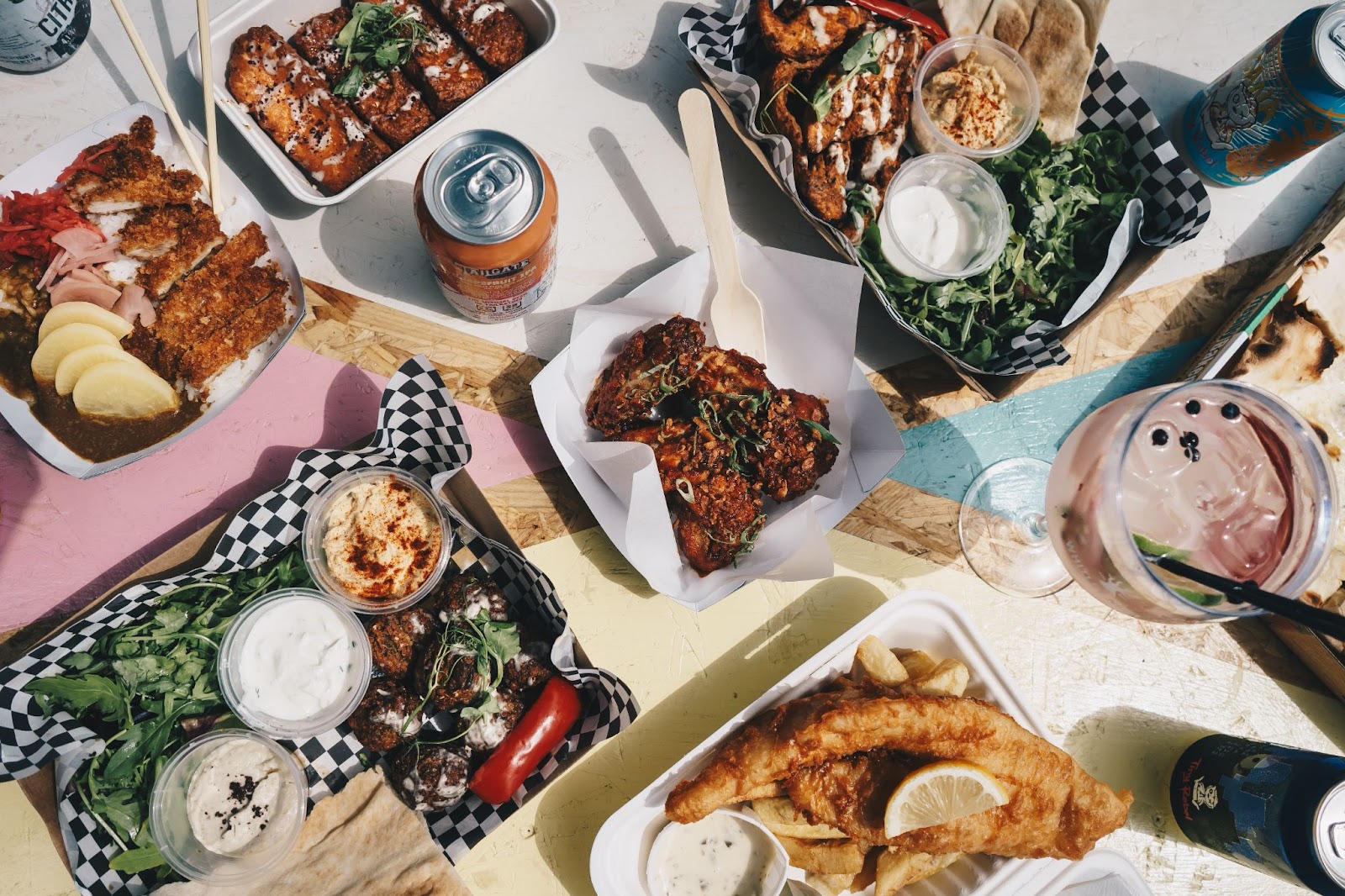
As a restaurateur, it takes considerable and thoughtful effort to build not just an appetizing menu, but also one that’s profitable.
With the cost of ingredients continuing to rise, business owners are seeking out more creative and strategic approaches to market their menu to patrons in high volume. But how to lure them in?
Like the saying goes, “a picture is worth a thousand words.”
While it’s common for menus to exclude pictures of the food, Instagram is a perfect platform to show off all the tantalizing dishes you prepare.
Taking attractive photos of food and posting them on social media is a low-cost, effective way to drive more traffic to your business—while also demonstrating your restaurant’s culinary skills and style.
If you’re a restaurateur looking to utilize the tools of food photography and technique to engineer your menu on social media, you’ve arrived at the right place.
What We’ll Cover in This Piece:
Why Attractive Images Matter When Marketing Your Menu

Photo by Toa Heftiba on Unsplash
Commonly, many restaurants opt for a menu that does not feature images of the food. Instead, they rely on descriptions, highlighted by ingredients or cooking style, to sell the dish.
That approach may work for customers already sitting down in your restaurant. But how did you even get those people through the door?
Posting high-quality images of your dishes across your social channels (especially Instagram) entices potential customers to try your business. Additionally, it allows you space to interact with potential patrons before they ever even sit down at your table (or after they sit down and dine with you, for that matter).
And the biggest advantage to posting food pics on Instagram? This type of marketing is completely free.
These days all you really need is an updated Smartphone and a couple time-tested tips and tricks.
Below you’ll find the best techniques for getting the right angle, lighting, and more to make all of your offerings Instagram (and drool) worthy.
The 7 Best Food Photography Tips

Photo by Brooke Lark on Unsplash
Taking your own photos will save you a ton of money versus hiring a professional photographer. And you certainly don’t need to be Ansel Adams to take a photo-worthy of a thousand likes. Having said that, there are a few food photography basics that you should follow to get the most out of your shot.
Here are some important things to consider:
Styling
Using props—like napkins, cutlery, and other tableware—lets you create layers of structure. You can even use staged sets to produce a narrative around the photo.
For example, add elements of the dish in the frame, like seasonings, garnishes, and ingredients. Or compliment the food with some cutlery, napkins, or candles to make your audience feel what it would be like to enjoy this dish at your restaurant.
Setting the stage helps transport potential diners into your restaurant and makes them feel like they want to go and enjoy your establishment’s experience in real life.
You have to look at the finished presentation of food, too. Work with your chef on a special way to dress the dish and then be sure to serve it “as seen on social” for an opportunity to make your dish trendy.

Photo by Ella Olsson on Unsplash
Lighting
This is a big one! Lighting can go wrong very quickly if you don’t understand how to allow it to work in your favor.
You should avoid using a camera flash at all costs here. Harsh lighting will hamper your food photos. Instead, when photographing food, stay by the window for natural light. Not only is ambient light the most complementary, but natural sunlight can also highlight the subject’s contours. Or even catch angles in ways that flash can not replicate.
Try lining up the shots you know you want to capture according to what photographers call the “golden hour”—the hour before sun or the initial hour after dawn.
If you’re struggling with shadows or glare, hold a piece of white paper or cardboard in front of the light source to bounce off the light.

Photo by Mantra Media on Unsplash
The Close-Up
A zoomed-in perspective clearly captures all the delicious details of a dish. For example, the rugged texture of asparagus, the glistening orange glaze on a seared duck breast, or the hidden nooks and crannies of a Caesar salad.
A close-up photo fills your frame. Imagine that effect while potential customers are scrolling on their smartphones. A gorgeous shot that takes up their entire screen will probably cause them to pause on social, liking the post or coming back for a second look!
Pro Tip: Take a close-up image using the “portrait” feature on your Apple or Android device for a softer, more focused capture.

Photo by Mantra Media on Unsplash
Angles and Perspective
Instead of just taking a generic flat shot, try shooting from multiple perspectives. Train your eye to see the dish in a new way. Think about a dish from every angle. Be curious about what the plate looks like from the side, in a depth of field, or in a serving hand.
For example, place the dish in the line cook’s window or even on a clean, crisp tablecloth. Allow yourself to find contrast in background elements to create a new vision of the dish.
Pro Tip: Not only does the final presentation of the dish matter, but so does the process of how it gets from the kitchen to the plate. Be encouraged to show customers a behind-the-scenes look at what it takes to bring a dish from the kitchen to your table.
Editing
Your best pictures can always use a little retouch. While it may seem easy to just apply a basic filter over your image, we encourage you to get acquainted with editing elements like contrast, saturation, and black point.
For example, if you were to apply a highlight edit to the image, it will alter the white balance to negate cool colors and produce warm ones. Applying the sharpening filter will enhance the details of the dish.
If you’d like to go one step further, download mobile editing apps like Lightroom or VSCO for additional touchup options.

Photo by Luke van Zyl on Unsplash
The Rule of Thirds
Your inclination may be to shoot your photos with your dishes front and center and square in the middle. Resist this urge! Instead, try out the rule of thirds.
In its plainest terms, the rule of thirds uses four lines to divide an image into a grid with three equal columns and three equal rows. Or nine boxes in total.
By placing the focal point of your photo at one of the intersection points, you create a more interesting visual and a better-balanced picture.
Final Touches
In today’s world, social media is one of the most effective ways to market your restaurant, your brand, and your dishes. By following these handy tips and tricks, you can drive more traffic to your establishment, increase your brand awareness, and build a loyal following in your community.
Other Content You May Enjoy
To succeed and grow your restaurant, bar, or brewery you need to stand out in local search results. Whether someone is searching for the “best craft beer near me” or “top-rated seafood restaurant in [your city],” Local SEO (Search Engine Optimization) helps your business appear at the top of those search results.
With 81% of consumers using Google Search and Maps to find local businesses, and nearly 90% of customers choosing a business on the first page of search results, optimizing your online presence is essential.
This guide will walk you through Local SEO strategies tailored for restaurants, bars, and breweries, covering Google My Business, website optimization, online reviews, local backlinks, and more.
By the end of this guide, you’ll have a step-by-step action plan to increase your search rankings, attract more local customers, and grow your business.
In today’s digital world, having a well-designed, functional website is essential for restaurants, bars, and breweries. It goes beyond having social media. A great website can help attract new customers, showcase menus, accept reservations, and even drive online sales. But one of the most common questions business owners ask is: How much should a website cost in 2025?
The answer depends on several factors, including the type of website, features, complexity, and whether you choose a DIY solution or hire a professional web developer. Costs can range from a few hundred dollars for a basic website to tens of thousands for a fully customized, feature-rich platform.
This guide will break down website costs for restaurants, bars, and breweries, helping you understand the pricing landscape and choose the best solution for your business
Trivia nights have become an incredible marketing strategy for bars, restaurants, and breweries to draw in crowds and engage with new customers. With the recent collaboration between Geeks Who Drink, Timeplay, and the iconic television show Jeopardy!, businesses now have an exciting opportunity to host the Jeopardy! Bar League. This partnership combines the global brand recognition of Jeopardy! with Timeplay’s cutting-edge technology and the fun of live trivia from the experts at Geeks Who Drink.
In this piece we’ll cover what this new collaboration between these two trivia powerhouses is and how you can bring this unique experience to your venue.
In today’s world, both websites and social media platforms are crucial for a brewery, bar, or restaurant’s online presence. However, consumer habits show distinct preferences for each, depending on the context of their search or interaction.
In this guide, we’ll go over the basics, walk you through how to leverage these tools effectively, and show you how understanding these trends can help your venue better meet your customers’ expectations.
As a restaurant, bar, brewery, or any venue with a food and beverage program, having a modern, functional, and aesthetically pleasing website isn’t just a luxury—it’s a necessity.
No matter the size of your business, your new potential customers often interact with your website first—and first impressions matter.
In this piece, we’ll explore the top website trends shaping the online presence of hospitality businesses in 2025. These trends will help your venue stand out and attract more customers while creating a unique and modern experience to establish the perfect guest experience from start to finish.
For bar owners, hospitality managers, and small business owners, selecting the right gin brands is more than just filling the shelves—it’s about curating a distinctive customer experience. Gin has soared in popularity, becoming a staple of modern cocktail culture. With its complex botanical infusions, gin offers versatile, memorable flavors that can attract a wide range of customers. But with so many choices available, which brands should you prioritize to bring out the best in your gin menu?
This guide explores the seven best gin brands that have proven themselves through quality, craftsmanship, and unique flavor profiles. By understanding what makes each brand special, you and your staff will be better equipped to create a standout gin selection that delights your patrons, reinforces your brand’s reputation with a robust gin drinks menu, and helps you continue crafting classic and innovative gin cocktails.

